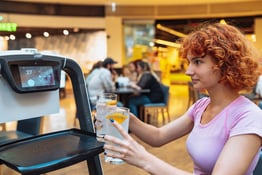To say that Covid-19 has upended the way we eat at restaurants would be an epic understatement. But as dining rooms moved out onto sidewalks and patios to keep customers and staff safe, an innovation soon popped up to take the industry by storm: bubble dining.
The trend caught on so quickly that soon enough it became hard to find a plastic bubble tent in stock anywhere. The dining pods became a way to brave the elements while still enjoying your favorite meal. Their key feature — the ability to hold air, and therefore, keep diners warm — was also their biggest potential drawback: namely, that they might make a perfect little petri dish for transmitting the virus among diners.
Did America embrace the bubble without fully weighing their pros and cons? It’s worth pausing a moment to consider the question before you go all-in on the dining tent craze. We’ve come up with a few pointers that can help you decide whether bubble tents are right for your restaurant, even beyond winterizing your outdoor dining.
Are plastic outdoor bubble tents Covid-safe?
The industry excitedly latched onto the images of plastic bubble tents, complete with table inside, when they began circulating in 2020. Could this be a way to continue sidewalk dining, the lifeline of so many restaurants, during cold weather? But many experts were quick to point out that the enclosures didn’t allow the kind of ventilation that necessitated the move from indoor to outdoor dining in the first place — for diners and staff alike.
So before you roll out a sea of bubble dining tents, consider that experts have fixated on the risk that the bubbles could foster when you’re serving a diner who is carrying Covid. “I would eat with my own family in one of those, but not with anyone else,” Linsey Marr, a civil and environmental engineering professor at Virginia Tech who studies airborne transmission of infectious diseases, told The Washington Post.
If you want to keep customers and staff safe, she recommends keeping the air flowing in your restaurant bubbles. “You don’t need to feel a breeze, but it definitely shouldn’t feel stuffy,” Marr recommends. “Smells shouldn’t build up in there.”
Whether your customers are eating in a yurt, an igloo, a dining dome, a mini-greenhouse, or some other sort of enclosure, they’re only going to be protected from parties at other tables. Truly they may not mind; if they’re dining at your establishment instead of crowding into an apartment together, their risk of exposure to each other is about the same. But you won’t want to market a bubble-dining experience as a covid-safe alternative to indoor dining, as it simply offers fewer safety benefits than sitting outside in the open air.
They also present a higher degree of risk to your staff than a purely outdoor setup, and must be turned over more slowly than regular tables. Iahn Gonsenhauser, chief quality and patient safety officer at the Ohio State University Wexner Medical Center, told The Wall Street Journal that a dining tent should be allowed to air out for 15 minutes between parties, and that every surface should be wiped down thoroughly before new diners are allowed to take the table. “You don’t want to be bumping anything with the potential to have collected particles,” the doctor said.
Do you have the budget for patio dome tents?
After the crucible that was 2020, there’s a good chance you don’t have a giant budget for a huge new outdoor dining setup. One simple reason? Everyone else was also rushing to accommodate outdoor dining. The run on outdoor heaters, folding tables, tents, Kotatsu tables, and indeed the humble bubbles made all those items scarcer and more expensive.
Speaking of, you have to budget to build out your bubbles. Every unit needs furniture, light, heat, and decor. Before you commit to rocking those domes, run quick P&Ls on your proposed temporary dining room. Make sure whatever you’re spending justifies the cost. Your better alternative might be to invest in a more versatile outdoor dining space.
Restaurant bubbles have their own local health regulations
Practically overnight, outdoor dining went from being a seasonal treat to an industry lifeline. Naturally many restaurants rushed to get their sidewalks and parking lots set up to serve customers. But take the time to check on what your local health regulations have to say about outdoor dining — especially when it comes to using a patio dome tent to house tables. Some states have gone so far as to ban the use of individual pods or tents.
Even in jurisdictions where bubble dining is legal, many local ordinances limit on how many diners can sit inside a fully enclosed space at once. Others only allow groups from the same household to be seated together. This might be no big deal if you’re using a set of small bubble dining domes for four- or six-tops. But if you invest in a large greenhouse dome or banquet tent with walls and just one door, you could stumble into major fines or closure orders for violating capacity limits. Before you spring on a solution and waste precious funds, make sure you’re in the clear to use the kind of outdoor dining setup you’re envisioning. When in doubt, reach out to your state’s restaurant association or your city or state’s health department.
How much of the year will you really use greenhouse domes?
In the fall of 2020 bubble dining may have saved a lot of restaurants at a precarious time. Covid cases were rising, temperatures were falling, and inflatable bubble tents created mini dining rooms that made customers comfy in rain, wind, or snow. Once we passed that dark winter, many cities loosened indoor dining restrictions, surely changing the value equation on bubble dining going forward.
Of course, no one can tell what the next phase of the pandemic will bring. But with specific outdoor dining allowances expiring in some places — and customers’ willingness to eat indoors still an unknown — it can’t hurt to keep an eye on safety. Your staff, your diners, and your bottom line will appreciate it.
Images of dining domes caught the media’s attention largely because of their sheer oddity. But novelty shouldn’t be the guiding rule for your restaurant. Depending on how much space you have, budget constraints, local rules, you might find that other options are more realistic or appealing than a clear dome tent. You might also find other options are safer so long as we’re fighting a pandemic. With the weather warming up as summer approaches, you might want to consider building out a roofed seating area or providing tables with umbrellas before investing in a set of limited-use tents.
[Photo by Yan Krukov from Pexels]





